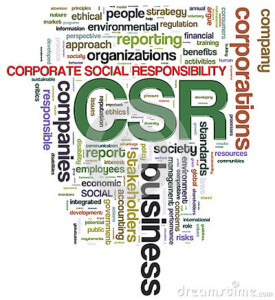Companies that embrace a socially responsible management approach – showing equal concern for people, the planet, and profits – succeed.
 The approach is called Corporate Social Responsibility (CSR), and it is an umbrella term with up to 80 elements, the most common being: corporate philanthropy, cause marketing, sustainability, supplier diversity, community engagement, and waste management.
The approach is called Corporate Social Responsibility (CSR), and it is an umbrella term with up to 80 elements, the most common being: corporate philanthropy, cause marketing, sustainability, supplier diversity, community engagement, and waste management.
For years, large companies have embraced CSR by sharing resources, supporting various communities and communicating values.
The good news is that the same principles apply to small and medium size companies, which they should embrace too.
Today, many consumers are interested in doing business with companies that reflect more than focusing on a single bottom line. In fact, 51% of consumers said they prefer to reward responsible companies with their business, and 53% said they would pay a premium (10%) for products from a socially responsible company.
Other benefits include: reducing costs, creating brand differentiation, strengthening community ties, innovating new products and methods. Plus, CSR attracts investors while limiting risks and addressing concerns of internal and external communities.
Yet embracing CSR eludes many business leaders so get you started here are seven steps to achieving CSR success.
Here are 7 steps to help small to medium size companies adapt this management approach.
Step 1 to CSR Success
List your business communities, i.e.,
- Employees
- Clients
- Prospects
- Trade Associations
- Municipalities
- Media
Step 2 to CSR Success
List your business goals, i.e.,
- Reduce turnover
- Increase market share
- Improve reputation
- Generate more leads
- Strengthen client loyalty
- Reduce waste
- Raise profits
Step 3 to CSR Success
Align business goals with social issues
For example, if your business sector is baby food, one goal may be to strengthen loyalty with mothers — a key community. To do that consider helping reduce childhood hunger – a critical social issue. First, be real. You cannot end world hunger. However, explore how you help a K-5 school in a blighted neighborhood. Could your company provide breakfast to each student for one school year? If not each student, what about one grade, one family, or volunteer to build a community garden?
The point is, no matter the business sector, you can leverage your resources to support your communities and stay focused to your business goals.
Step 4 to CSR Success
Find the right partners
Nearly every social issue has a non-profit organization to support it. However, do not partner with the first non-profit you meet. Instead, qualify them. That insight is critical when building long-term social partnerships to strengthen connections and inspire passion/commitment.
- How are their finances?
- Is their Board active and free of negative drama?
- Does their mission match yours?
- Where is their strongest presence – local, regional, national, or global? Does that align with your business?
Step 5 to CSR Success
Build credibility; Walk-the-talk
For example, if one business goal is to reduce waste then be more sustainable.
- Avoid disposable goods, such as paper plates, napkins, cups, razors, or lighters.
- Buy durable goods — ones that are well-built or that carry good warranties. They will last longer, save money in the long run, and save landfill space.
- Make two-sided copies when ever possible.
- Maintain central files rather than using several files for individuals.
- Use email or main bulletin board.
Step 6 to CSR Success
Communicate your efforts
Effective communication includes a consistent, transparent message that clearly communicates your values and efforts. Yes, your marketing/branding department will benefit from this stage, however it is important to choose messages and strategies that will not label as “greenwashing” and only engaging in CSR as a public relations ploy.
For example, if you are organizing a volunteer day, post it on your favorite social media platform and let people know they can join in the fun. Then post pictures, videos, and comments from the volunteers and benefactors.
Your communication goal is to brand your business as one that cares and supports its communities — employees, clients, suppliers, municipalities, or non-profits.
Step 7 to CSR Success
Measure your impact
Core CSR business drivers are generally HR policies, sustainable practices, and diversity initiatives. Their value can be measured with reduced turnover, reduced waste, and increased inclusions within various departments: production/manufacturing, marketing/PR, operations, accounting/finance, sales, R&D, IT, and administration.
What’s the take away?
Some companies find it enough to donate money and market those efforts. However, many small to medium size companies cannot match those contributions, nor is making a donation enough.
If you are looking to transform your business and its brand, embrace CSR as a management tool. It will make a positive community impact, plus it will distinguish you as an industry leader and a community warrior.
* Source: Group M, Interaction Extract 2012
This article was originally written for YourVelocity an educational business website.